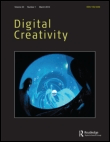
DIGITAL CREATIVITY
Scope & Guideline
Fostering Dialogue on the Evolution of Digital Expression
Introduction
Aims and Scopes
- Digital Arts and New Media:
The journal emphasizes the role of digital technologies in artistic practices, including immersive storytelling, virtual reality, and interactive installations, exploring how these mediums transform traditional art forms. - Cultural Heritage and Preservation:
Research on the integration of digital technologies in preserving and interpreting cultural heritage is a core area, highlighting innovative approaches to heritage communication and education through digital storytelling. - Interactive Design and User Experience:
The journal explores methodologies in design, particularly user-centered and participatory design practices, focusing on how digital tools enhance user engagement and creativity in various applications. - Technological Impact on Creativity:
Investigations into the psychological and sociotechnical aspects of creativity in digital contexts, including the use of artificial intelligence and virtual environments, are central, examining how technology shapes creative processes. - Community Engagement through Digital Media:
Research that investigates the role of digital platforms in fostering community participation and engagement in creative practices, including mobile applications and augmented reality experiences.
Trending and Emerging
- Immersive and Interactive Experiences:
There is a marked increase in research on immersive technologies such as virtual reality and augmented reality, particularly in their application to storytelling and art, reflecting a trend towards experiential engagement in creative practices. - Artificial Intelligence in Creativity:
The integration of AI into creative processes is becoming a prominent theme, with studies examining how AI tools can enhance or redefine artistic expression, indicating a growing interest in the role of algorithmic creativity. - Digital Preservation and Cultural Heritage:
Research focusing on the preservation of cultural heritage through digital means is on the rise, showcasing innovative approaches such as NFTs and digital storytelling to safeguard and communicate heritage values. - Community and Social Engagement through Digital Media:
Emerging themes around community engagement and participatory practices using digital platforms reflect a growing recognition of the role of technology in fostering social interaction and creative collaboration. - Critical Perspectives on Digital Tools:
There is an increasing trend towards critical analyses of digital tools and their implications for creativity, including ethical considerations and the impact of technology on user experience and societal values.
Declining or Waning
- Traditional Artistic Methods:
As the journal increasingly emphasizes digital and immersive technologies, research centered on traditional artistic methods and practices appears to be less frequent, indicating a possible waning interest in non-digital forms of creativity. - Physical Craft Techniques:
Although the journal has published articles on the intersection of digital and physical crafts, there is a noticeable reduction in papers that focus solely on traditional craft techniques, suggesting a shift towards more digitally mediated practices. - Analyses of Pre-Digital Art Movements:
Research that examines historical art movements or techniques that predate digital innovation seems to be declining, as the journal prioritizes contemporary digital practices and their implications for creativity.
Similar Journals
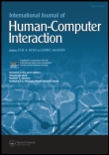
INTERNATIONAL JOURNAL OF HUMAN-COMPUTER INTERACTION
Pioneering Insights in Human-Computer DynamicsINTERNATIONAL JOURNAL OF HUMAN-COMPUTER INTERACTION, published by Taylor & Francis Inc, stands at the forefront of research within the interdisciplinary fields of human-computer interaction, human factors, and ergonomics. Since its establishment, the journal has consistently contributed to advancing the understanding of the interactions between people and computers, making it a vital resource for researchers, professionals, and students alike. With an impressive impact factor reflecting its high citation rate, this journal is recognized as a Q1 publication in both Computer Science Applications and Human Factors and Ergonomics categories for 2023, showcasing its stature within the academic community. Additionally, it boasts a commendable ranking within the top percentiles in key areas on Scopus, ensuring that the research published here reaches broad scholarly audiences. Available in traditional subscription format, the journal covers seminal studies from 1989 to 2024, reflecting ongoing innovation in technology and its applications in everyday life, and thus serves as an essential platform for pioneering research that shapes the future of user experience.
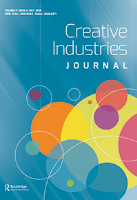
Creative Industries Journal
Pioneering Insights into the Future of the Creative IndustriesCreative Industries Journal, published by Taylor & Francis Ltd, is a premier academic publication that focuses on the intersection of creativity, culture, and commerce. With an ISSN of 1751-0694 and an E-ISSN of 1751-0708, this journal has solidified its reputation in the fields of Communication, Cultural Studies, and Visual Arts, achieving impressive rankings in Scopus, including a 95th percentile in Visual Arts and Performing Arts. Since its inception in 2011, the journal has served as an integral platform for researchers, professionals, and students keen on exploring the innovative practices and dynamics that define the creative industries. With an emphasis on interdisciplinary approaches, the journal is committed to advancing scholarship and dialogue around the evolving landscape of cultural production and technological innovation, aiming to shape the future of creative practices. As an essential resource for anyone engaged in these fields, the Creative Industries Journal continues to foster critical discourse and disseminate groundbreaking research.

Virtual Archaeology Review
Exploring New Frontiers in Archaeology and Conservation.Virtual Archaeology Review, published by UNIV POLITECNICA VALENCIA, EDITORIAL UPV, is a distinguished open-access journal dedicated to the dynamic fields of archaeology and conservation. Based in Spain, this journal has made a significant impact in the academic community, reflected in its outstanding Q1 ranking in Archeology and Conservation for 2023, alongside impressive standings in related disciplines such as Computer Science Applications. With an active commitment to promoting the accessibility of knowledge since 2010, it provides a platform for researchers, professionals, and students to share innovative findings and methodologies in virtual archaeology, fostering collaboration across disciplines. The journal's impact factor and its strategic focus on advancing the practice of virtual methodologies in archaeology underscore its vital role in bridging technology and heritage studies. By embracing a multidisciplinary approach, Virtual Archaeology Review not only enhances academic discourse but also drives the development of effective conservation strategies, making it an essential resource for those dedicated to the preservation and appreciation of our cultural heritage.
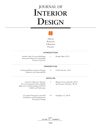
Journal of Interior Design
Unveiling the Impact of Interior Spaces on Society.The Journal of Interior Design, published by SAGE Publications Inc., is a premier peer-reviewed academic journal dedicated to the field of interior design. Established in 1975, this journal has been a pivotal platform for disseminating cutting-edge research, innovative design practices, and critical theory in interior spaces. With an impressive Q1 ranking in the Visual Arts and Performing Arts category and a 95th percentile ranking among its peers in arts and humanities, the journal reflects the highest standards of academic excellence. Although it does not offer open access, it provides valuable insights and findings relevant for researchers, professionals, and students alike, enhancing the understanding of interior environments and their impact on human behavior and society. As the field continues to evolve, the Journal of Interior Design serves as an essential resource for thought leadership and scholarly discourse.

Artnodes
Bridging Cultures Through Artistic ResearchArtnodes is a prominent academic journal published by UNIV OBERTA CATALUNYA, making significant contributions to the interdisciplinary fields of Arts and Humanities, Cultural Studies, and Computer Science. With an ISSN of 1695-5951 and an E-ISSN of 1695-5951, this Open Access journal has been accessible to the global community since 2002, encouraging the dissemination of innovative research and artistic exploration. Distributed from its headquarters in Barcelona, Spain, Artnodes has established itself as a vital resource, particularly in the domains categorized under Visual Arts, Performing Arts, and Literature, boasting a Q1 ranking in several areas for 2023. The journal is also noted for its impact in computer graphics and design, highlighting the integration of technology and art. With an impressive Scopus rank of #134 in Visual Arts and Performing Arts, this journal remains a critical forum for scholars and practitioners alike, facilitating dialogue and advancing knowledge across disciplines.

IEEE COMPUTER GRAPHICS AND APPLICATIONS
Bridging Theory and Practice in Visual ComputingIEEE Computer Graphics and Applications is a premier journal published by the IEEE Computer Society, focusing on the rapidly evolving fields of computer graphics and computer-aided design. With an established history since 1981, this journal has become a vital platform for disseminating innovative research and applications that bridge theory and practice. It is indexed in Scopus, holding a respectable rank of #49 in Computer Graphics and Computer-Aided Design and #250 in Software, reflecting its significant contribution to the academic community with a notable 54th and 38th percentile, respectively. While it currently operates without open access options, the journal continues to provide valuable insights that cater to researchers, professionals, and students alike, striving to push the boundaries of technology and creativity. With plans to converge until 2024, IEEE Computer Graphics and Applications remains committed to fostering advancements in the discipline, making it an essential resource for those at the forefront of computer graphics innovation.
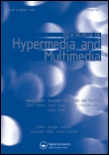
New Review of Hypermedia and Multimedia
Transforming Understanding of Digital EnvironmentsThe New Review of Hypermedia and Multimedia, published by Taylor & Francis Ltd, serves as a vital platform for scholars and practitioners in the dynamic fields of computer science, media technology, and information systems. Established in 1995 and continuing through 2024, this journal explores the interplay of hypermedia and multimedia within digital environments. With an ISSN of 1361-4568 and an E-ISSN of 1740-7842, it has achieved noteworthy rankings, including a Q3 classification in Computer Science Applications and Information Systems, and a Q2 classification in Media Technology as of 2023. Additionally, it ranks 19th in Engineering Media Technology with a remarkable 70th percentile. While the journal maintains a subscription model, it performs a critical role in disseminating cutting-edge research and fostering innovation among researchers, professionals, and students alike. Aimed at enhancing understanding and application of hypermedia and multimedia technologies, this journal is an indispensable resource for those at the forefront of these evolving disciplines.
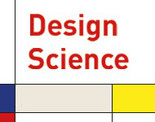
Design Science
Pioneering Research at the Forefront of Design.Design Science, published by Cambridge University Press, is a premier open access journal that has established itself as a leading platform for innovative research in the interdisciplinary field of design. Since its inception in 2015, the journal has focused on integrating design theories with practical applications across various sectors, including engineering, visual arts, and simulation modeling. With a remarkable impact factor and high rankings in multiple categories—Rank #11/667 in Visual Arts and Performing Arts and Rank #79/307 in General Engineering—Design Science commands a prominent position, being ranked in the top 98th, 76th, and 74th percentiles within its respective fields according to Scopus. The journal's dedication to open access ensures that cutting-edge research is accessible to a global audience, fostering collaboration and dialogue among researchers, professionals, and students alike. This journal not only aims to advance the understanding of design sciences but also serves as a vital resource for those seeking to explore the evolving dynamics of design practice in a rapidly changing technological landscape.
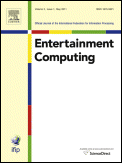
Entertainment Computing
Navigating the Digital Landscape of Entertainment InnovationEntertainment Computing, published by ELSEVIER SCI LTD, is a leading journal that explores the intersection of computing technology and entertainment, encompassing a wide range of topics from video games to interactive media. With an ISSN of 1875-9521 and an E-ISSN of 1875-953X, this esteemed publication caters to an interdisciplinary audience, including researchers, industry professionals, and students. Since its inception in 2009, the journal has achieved impressive recognition in the academic community, ranking in the Q2 quartile for both Computer Science Applications and Human-Computer Interaction, as well as Software, according to the 2023 category quartiles. The journal's commitment to high-quality, peer-reviewed research is reflected in its Scopus rankings, where it currently stands at Rank #142/407 in Computer Science Software and Rank #62/145 in Human-Computer Interaction. With its focus on innovative research that advances the understanding of how technology shapes our entertainment experiences, Entertainment Computing plays a pivotal role in fostering scholarly discussion and practical applications in the field.
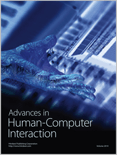
Advances in Human-Computer Interaction
Innovating the way we connect with machines.Advances in Human-Computer Interaction is a premier peer-reviewed journal published by HINDAWI LTD, dedicated to the exploration of cutting-edge research and innovation in the field of Human-Computer Interaction (HCI). With an ISSN of 1687-5893 and an E-ISSN of 1687-5907, this Open Access journal has been contributing to the scientific community since 2008, offering unrestricted access to critical findings and advancements. Based in Egypt with an address at ADAM HOUSE, 3RD FLR, 1 FITZROY SQ, LONDON W1T 5HF, ENGLAND, it occupies a notable position in the academic landscape, reflected in its 2023 Scopus ranking of Rank #57/145 and a 61st percentile in the Human-Computer Interaction category. As a Q3 journal, it plays a crucial role in disseminating research that bridges the gap between humans and technology, providing valuable insights for researchers, professionals, and students pursuing expertise in this dynamic field. The journal’s converged years from 2010 to 2024 signify its ongoing commitment to advancing knowledge and fostering collaboration among HCI experts worldwide.